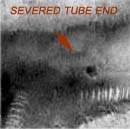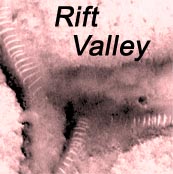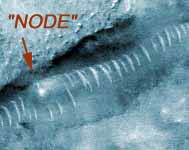

|
"TUBES" | |
|
Primary Anomaly: |
MO4-00291 Mare Acidalium "Sample of fine channels" |
|
Adjacent Anomalies: |
M02-01270 Mare Acidalium "Giant polygons in Acidalia Planitia" M03-00102 Mare Acidalium "Lighter surface in contact with darker cracked surface in Acidalia" |
|
Disparate Anomaly: |
M00-01674 Oxia Palus "Transect of flow-ejecta crater" **NOTE** "Tube" is seen in gully along north crater rim. |
|
Description: |
Glassy semi-transparent linear feature with a regular convex, cylindrical shape having typical diameters ranging from 140 yards and greater with somewhat regular supporting arch structure. Evident "craters" associated with this linear structure do not have typical impact crater shape and appear to be connected to the linear structure via shallow sup-surface tubes. |
|
Discovered by: |
Numerous. Tube Theory presented by Mars UnEarthed/ Tripp McCann |
|
*NOTE *- In viewing any of the MOC imagery in detail, it is recommended you download sinusoidal projected 'losless GIF" for any given image footprint. These GIF images at times are so large that browsers cannot display them and they should be downloaded by right clicking the link and choosing "save as.." | |
|
This document refers to a striking anomalous linear structure or structures having a regular convex cylindrical shape as "Tubes". These Tubes are evidenced in numerous Mars Orbital Camera <MOC> images released by NASA/JPL/MSSS NASA/MSS/JPL have given only one cursory attempt at explaining These anomalous structures which is available at http://www.jpl.nasa.gov/releases/2000/mgsarchive.html
The above passage is *ALL* we've gotten from NASA addressing this AMAZING anomaly, and not even mentioning the image profile by name.. amazing 140 YARD diameter and larger glassy Tubes with regular supporting arch structure and NASA doesn't even talk about it specifically in a PRESS CONFERENCE! If JPL is attempting to explain these tubular formations using "wind" as the cause and if they are referring to them as "certain ridges that look like dunes" then they are grossly ignoring the salient features of these structures. Beyond the fact that no known volcanic, erosional, morphologic, geochemical or metamorphic processes can produce these structures, I have outlined numerous important features which indicate why these structures can NOT be natural formations and MUST be non-natural constructions:
|
|
|
Vitreous glassy translucent tubes which demonstrate evidence of both reflection and refraction characteristics in places. . The albedo properties of these "tube" structures indicate they consist of material wholly different from that which typifies the surrounding topography. These vitreous glassy refraction and transparency properties are particularly evident on the "nude" and the along the tube north of the "node". |
|||||||
|
|
The tubes appear to be hollow and, indeed, in one area just east of the rifts joining together to form the "rift valley" there is a smaller tube which is clearly severed, the hollow void can be seen at the truncated end of the tube.(shown in detailed image just to the east of the central rift joint) Also the "stained vent" shown in #10 shows not only a slanted bottom and void on the side of the tube, but also shows light entering the open vent area from the tube region. |

|
||||||
|
|
These tubes are articulated with somewhat regular supporting arch structures. These arch structures appear to remain vertical even as these tubes themselves "plunge" into the Rift Valley, thereby serving as a counter to gravity for support and demonstrating that the arches are not simply perpendicular to the tube trend direction, but rather structurally orientated to support the "Tube" itself. |

|
||||||
|
|
The Arches are uniformly opaque and not transparent like the glassy "tubes" themselves, indicating that they are of a different composition than the tubes. |
|||||||
|
|
The tubular Arch structures remain intact despite the tube being destroyed by an evident landslide, seen in the rift branch to the EAST of the tri-radiate rift valley. Amidst the lobate shape of the landslide which has destroyed the tube itself, can be seen the enduring arches, indicating these arches are of a different construction and more resilient than the tube itself. |
|||||||
|
|
||||||||
|
|
Evidence of a "node" or bump on the northern tube traveling along the northern branch of a rift valley in M02-01270, the primary anomaly area. This node marks the general area where two separate and distinct tubes join together, evidencing a simultaneous or separate construction later joined together. In the vicinity of this "node" you may note ONE arch and possibly more traversing both tube structures to solidify their jointure. The joining of these two separate tubes and the regularly spaced arches having a varied distance between them indicate that these tubes and arches were constructed in situ <in place>. Also, The structure of the tubes and irregular placement of the supporting arches point to a structure whose purpose is utilitarian rather than strictly structured for aesthetics. |

|
||||||
|
|
Depressions in the Mars surface that initially appear to be impact craters but on further inspection are more accurately "Vents" which connect clearly with the tubes. The approach of the tubes to the vents is sometimes evident even beneath the Martian surface and at other times the interconnecting tubes are entirely visible up to the vents themselves. |
|||||||
|
|
These vents do not demonstrate the typical concoidal bottom typifying meteor impacts, but rather have bottoms which deepen on the side of the approaching tube and appear to have voids interconnecting them with these tubes. The glass-like tubes and associated vents are not structures ever seen, even associated with a volcanic environment
|
|||||||
|
||||||||
|
|
Apparent declining circular "ramps" into the larger and deeper of these "vents" appear to facilitate access to these deeper vents. Conceivably these spiral ramps, could be the result of exiting gasses from the tubes spiraling as a result of the coriolis force of the planet's rotation causing the gasses to spiral as they rise vertically through the large vertical rise out these bigger vents. This coriolis induced rotation of the gasses could conceivably cause the gasses to scour a spiral ramp-like structure over time, yet this is unlikely. The direction of spiral is counter directionally to the coriolis rotation that would be induced by the planet's rotation. |
|||||||
| Numerous vents show ash buildup surrounding their apertures. This ash buildup is not "ejecta" as would be associated with an impact crater; it has a softer and has mottled diffuse dispersal pattern typical of ash outfall. Some vents even show soot-like staining on their lips that are proximal to the more vertical edge as defined by the visually evident approaching tube. (Most notably M02-01270) | ||||||||
|
|
|
|||||||
|
There have been many proposed explanations for these "tube"
structures. Many attempt to explain them away as dune structures, claiming
that the arches are similar to this
wonderful color image from mars. This image only mildly resembles the regular tube
and arch because the dunes, or "dune train", are contained within narrow valley walls and
the dune edges do not dissipate as they would typically. Even NASA itself
has made only a faint attempt to dismiss these structures as dunes, backing
off saying " They aren't dunes because they occur too close together;
their crests are too sharp, their slopes too symmetrical. They often appear
to be a specific layer of material that has undergone erosion -- we just
wish we knew what processes are involved that cause this kind of erosion."
NASA is quite clearly aware that these are not erosional features
from wind or water. If you look closely in the "node" area you
can see a sort of "epoxy" similar to the tube material attaches
the tube to the rift wall on the northern branch. Some have wanted to claim that the tubes are a conveyance system ---
a sort of alien highway system. This is highly unlikely because the tubes
show no interconnectivity even when the branches converge on the rift
valley center. This could make traveling from point "A" to point
"B" very frustrating, to say the least. While there is evidence
that some tubes do "branch" off of other tubes, this is a sort
of bifurcation or "splitting up" of the tubes from the point
of origin, the "rift valley" , where three major tubes "plunge'
vertically into central of the rifting. This bifurcation or splitting
off of the tubes into separate directions is consistent my theory of their
purpose being the dispersal SOMETHING from a point of origin. Some have proposed these structures to be a "plumbing" system
or a water conveyance system, or aqueduct. Richard Hoagland of "Enterprise Mission"
is one of the more well recognized proponents of the "plumbing"
explanation. These tube structures would serve poorly for such a water
conveyance system as a result of their numerous, clearly evident "vents"
resulting in a system that is not "closed" and would contain
numerous "leaks." Additionally access to liquid water would
be difficult at best in the frozen Martian environment, estimated to have
a permafrost as deep as 3 miles. While this Mare Acidalium region was once a Mars Sea and water was readily
available, there is no access to fluid water now and a water conveyance
system with tubular diameters exceeding 140 yards would be excessive.
When water was present in this region there would be no need to have the
tubes converge on and dive into the rift valley, which may exceed 1 1/2
miles in depth.
While the Rift Valley could have resulted when the paleo sea dried up
and desiccated sediments "cracked" leaving gaping fractures,
I believe the rift valley has its origins with a localized volcanic "hot
spot". The rift Valley exhibits the typical tri-radiate fracture
arms emanating from volcanic rifts over "hot spots" seen all
over Earth. <In depth
explanation of "hot spots" and rifting> The hot spot
would be a likely source of frequent emissions of hot volcanic gasses
into the thin Martian atmosphere. This Martian atmosphere is much poorer
than Earth's atmosphere at disseminating heat through conduction and thermal
convection, as a result of its thinness. This would result in extremely
high and localized thermal gradients in the atmosphere, which would lead
to strong and enduring storms enveloping the Mars surface. Evidence of
this being a concern on Mars was seen as the ill-fated Mars Polar Lander
was within 3 months of reaching Mars. A geyser near the equator erupted
and vapor rose to the stratosphere, drawing dust along with it. Horrified
NASA officials watched as the turbulence then spread, finally enveloping
Mars from pole to pole and leaving NASA concerned it might have to scrub
the Polar Lander mission entirely. These storms are similar in origin
to Earth's own hurricanes which begin as steep thermoclines over the Sahara
desert and then travel across the Atlantic Ocean, often adversely affecting
the North America coast. The tubes serve as a distribution system for the volcanic gasses which
travel along the tube's length using the expulsive force of the gasses
themselves to convey them. The hot gasses are then expelled at widely
dispersed "vents" which minimize localized thermal gradients
and disperse heated gasses throughout the encompassed vent area, minimizing
the volatile effect of the hot gasses to the Martian surface. Evidence
of the tubes radiating from and diving into the rift central valley supports
this. Further corroboration by obtaining more extensive narrow-angle
imagery is need to delineate the tube structures more distant from the
primary anomaly's Rift so as to ascertain if they have any evident correspondence
with other volcanic rift areas and establish if further vent structures
are also associated with these tubes.
Also, some have pointed to other features mildly similar to the "Tubes" presented herein and called these features "tubes" or "plumbing" as well, among these Richard Hoagland. In two presentations on his web site, "Enterprise Mission" on 6/22/00 and 6/28/00 Mr. Hoagland presented two articles where he puts forth "plumbing" entitled "Where's A Good Plumber When You Need One?" and "Martian Pipelines Pose Profound Problems ... for NASA", respectively. In one of these articles he even compares this "feature" with the Alaskan oil pipeline, showing a comparative picture of the pipeline. While some of the anomalies Hoagland presents in these articles are enigmatic and in need of further research, many of them are of a common feature in volcanic flows. To the RIGHT is one image of this volcanic feature which Hoagland took from FHA-01405 and entitled "Close-up of systems distribution node and systems plumbing" The periodic rounded linear forms in this image and others are p-waves or "pressure waves" which are typically perpendicular to flow direction and seen associated with more fluid types of volcanic flows. We commonly see this p-wave form when we are washing our cars and the water is running down the driveway; periodically wavelets will flow down amidst this water flow and these wavelets are p-waves. Volcanic flows are more viscous than water so the pressure waves travel slower and become compacted together. I had the good fortune to study the active volcanics on the Big Island of Hawaii with the U.S.G.S in 1983 shortly after the ongoing eruptions began anew following a 20 year quietus. I then did walk among a landscape covered with these p-waves frozen in the pahoehoe lava flows, both old and new.
I have great respect for Mr. Hoagland and find that he has "hit
the mark" more often than not and beyond doubt we likely owe the
release of these 27,000+ images from NASA/JPL/MSSS in no small part to
his enduring tenacity. Unfortunately Mr. Hoagland failed to recognize
a common volcanic flow form here, although he did find features of striking
scale and stunning beauty. In brief, the tube system seems to serve as a sort of "Terraforming" effort, dispersing hot volcanic gasses over a wide region thereby minimizing the more volatile affects of the "normal" Martian environment and making the planet surface more habitable. The radiate arms of the rift valley are used to cradle the tubing structure as it disseminates from the rift center, protecting the tubes from damage in Martian average 300 m.p.h. winds and, perhaps also concealing the tubes from being readily observed from overhead. |
|
|
since 7/24/00